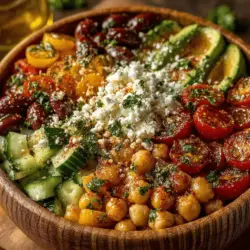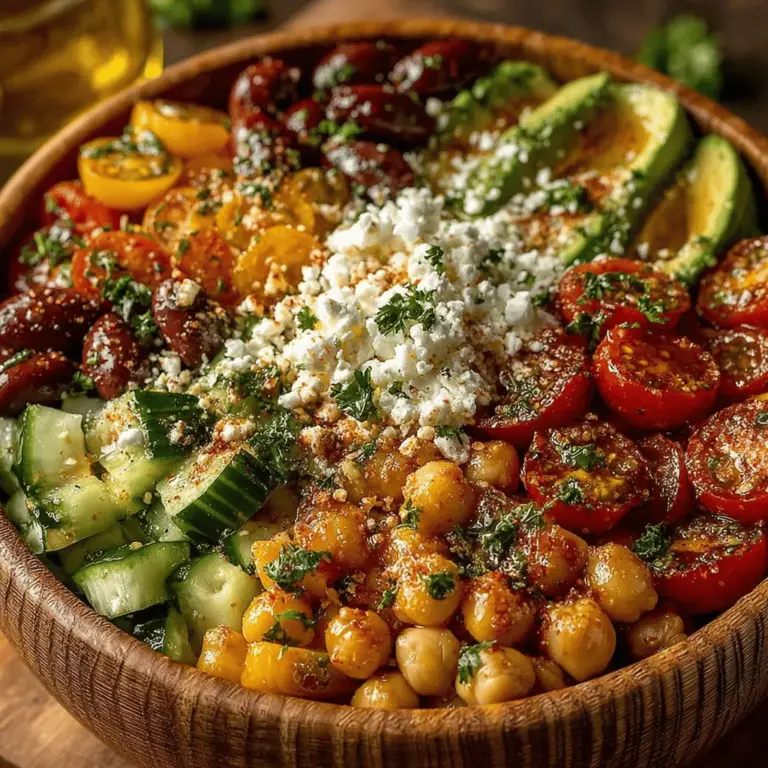Introduction
The Mediterranean Chickpea Salad Bowl is not just a meal; it’s a vibrant experience bursting with flavors and textures that celebrate the essence of the Mediterranean diet. This wholesome dish combines the earthy richness of chickpeas with a medley of fresh vegetables and a zesty dressing, making it a nutritional powerhouse. With its colorful presentation and aromatic ingredients, this salad bowl invites you to enjoy a culinary journey through the sun-kissed landscapes of the Mediterranean region.
Originating from countries that embrace the Mediterranean lifestyle, such as Greece, Italy, and Spain, this salad embodies the principles of a diet that prioritizes fresh, whole foods. The Mediterranean diet is renowned for its health benefits, including reduced risks of heart disease, improved cognitive function, and enhanced longevity. By incorporating a variety of fruits, vegetables, whole grains, and healthy fats, this dietary approach promotes overall well-being.
In this article, we will dive into the delightful elements that make this salad bowl a must-try. We will explore the health benefits associated with its ingredients, discuss how chickpeas fit into a healthy lifestyle, and provide a comprehensive step-by-step guide to crafting the perfect Mediterranean Chickpea Salad Bowl in the comfort of your own kitchen.
Understanding the Mediterranean Diet
The Principles of the Mediterranean Diet
At its core, the Mediterranean diet emphasizes the consumption of whole, minimally processed foods. Key principles include a high intake of fruits and vegetables, whole grains, legumes, nuts, and seeds, complemented by moderate consumption of dairy, fish, and poultry. Red meat is enjoyed sparingly, and healthy fats, primarily from olive oil, are favored over saturated fats. This balanced approach not only nurtures the body but also encourages a lifestyle filled with communal meals and shared experiences.
Exploring the Nutritional Benefits
The Mediterranean diet is rich in essential nutrients, offering a bounty of vitamins, minerals, and antioxidants. Fruits and vegetables are packed with vitamins A and C, potassium, and fiber, all of which contribute to optimal health. The inclusion of legumes like chickpeas provides a significant source of plant-based protein, making it easier for individuals to meet their dietary needs without relying heavily on animal products. The healthy fats from olive oil and nuts support heart health, while the abundance of whole grains helps maintain stable blood sugar levels.
Research has consistently shown that those who adhere to the Mediterranean diet experience lower rates of chronic diseases, including obesity, diabetes, and certain types of cancer. The emphasis on variety and quality of ingredients encourages a sustainable and enjoyable way of eating that can be maintained over the long term.
How Chickpeas Fit into a Healthy Lifestyle
Chickpeas, also known as garbanzo beans, are a staple in Mediterranean cuisine and an integral part of this salad bowl. They are not only versatile but also incredibly nutritious. Packed with protein, fiber, and essential vitamins and minerals, chickpeas serve as an excellent foundation for a balanced meal. Their high fiber content helps regulate digestion and promotes a feeling of fullness, making them an ideal choice for weight management.
In addition to their nutritional benefits, chickpeas are incredibly easy to incorporate into various dishes. Whether used as a base for salads, blended into hummus, or roasted for a crunchy snack, they adapt well to a multitude of flavors and cooking methods. Their nutty flavor and creamy texture make them a delightful addition to the Mediterranean Chickpea Salad Bowl, complementing the fresh vegetables and tangy dressing.
Ingredients Breakdown
Fresh Produce Essentials
To create a truly memorable Mediterranean Chickpea Salad Bowl, selecting fresh and high-quality produce is essential. Key ingredients typically include vibrant vegetables such as cucumbers, bell peppers, red onions, and tomatoes. Each vegetable brings its unique flavor and texture to the dish, enhancing the overall experience.
– Cucumbers: Crisp and refreshing, cucumbers add hydration and a cool crunch.
– Bell Peppers: Available in various colors, bell peppers provide sweetness and a pop of color.
– Red Onions: Offering a mild sharpness, red onions balance the flavors and add depth to the salad.
– Tomatoes: Juicy and ripe, tomatoes contribute acidity and freshness, tying all the components together.
The combination of these vegetables not only elevates the dish visually but also ensures a wide array of nutrients, making each bite both satisfying and nourishing.
Importance of Quality Ingredients
When it comes to preparing a Mediterranean Chickpea Salad Bowl, the quality of ingredients cannot be overstated. Opting for organic and locally sourced produce can significantly enhance the flavor and nutritional value of the dish. Fresh herbs, such as parsley, cilantro, or mint, can elevate your salad to new heights, providing aromatic notes and vibrant color. Additionally, using high-quality extra virgin olive oil for the dressing ensures you get the maximum health benefits while enhancing the overall taste.
The Role of Chickpeas in the Recipe
Chickpeas are the star of this Mediterranean salad, offering not only a hearty base but also a wealth of nutritional benefits. Their plant-based protein content makes them an excellent choice for vegetarians and vegans seeking to boost their protein intake. Furthermore, chickpeas are a rich source of soluble fiber, which supports heart health by helping to lower cholesterol levels.
In the Mediterranean Chickpea Salad Bowl, chickpeas can be used in their canned form for convenience or cooked from dried for a more authentic experience. Either way, they should be rinsed and drained before adding to the salad to remove excess sodium and improve digestibility.
Step-by-Step Preparation Guide
Preparing the Chickpeas
If using canned chickpeas, start by draining and rinsing them under cold water to eliminate excess sodium and improve their flavor. For those opting for dried chickpeas, begin by soaking them overnight in plenty of water. This process helps soften the beans and reduces cooking time. The next day, drain and rinse the soaked chickpeas, then cook them in a pot of boiling water for approximately 1 to 1.5 hours or until tender. Once cooked, allow them to cool before incorporating them into your salad.
Chopping the Vegetables
While the chickpeas are cooling, it’s time to prepare the fresh vegetables. Begin by rinsing all produce thoroughly to remove any dirt or pesticides. Chop the cucumbers, bell peppers, and red onions into bite-sized pieces, ensuring uniformity in size for a more appealing presentation. Dice the tomatoes, taking care to remove excess seeds to prevent the salad from becoming too watery. Finally, chop your chosen fresh herbs, adding a burst of flavor and freshness to the dish.
Incorporating Olives and Feta
To elevate your Mediterranean Chickpea Salad Bowl, consider adding kalamata olives and feta cheese. Olives bring a briny richness that complements the other ingredients beautifully, while feta adds a creamy, tangy element. Chop the olives coarsely and crumble the feta cheese before mixing them into the salad. These ingredients not only enhance the flavor profile but also contribute additional nutrients, making the dish even more satisfying.
Creating the Dressing
A zesty dressing is crucial for tying all the components of the salad together. In a small bowl or jar, combine extra virgin olive oil, lemon juice, minced garlic, and a pinch of salt and pepper. Whisk or shake well to emulsify the dressing, creating a smooth and flavorful mixture. This dressing balances the dish, adding acidity that brightens the flavors of the vegetables and chickpeas. Adjust the seasoning to taste, ensuring the dressing complements rather than overpowers the main ingredients.
Combining and Tossing the Salad
Once all components are prepared, it’s time to assemble your Mediterranean Chickpea Salad Bowl. In a large mixing bowl, combine the chickpeas, chopped vegetables, olives, and feta cheese. Drizzle the dressing over the top and gently toss everything together to ensure even distribution of flavors. Be careful not to crush the chickpeas or feta during this process. The goal is to create a colorful and cohesive salad that showcases the vibrant ingredients while maintaining their individual textures.
This Mediterranean Chickpea Salad Bowl not only serves as a delicious main dish or side but also embodies the principles of healthy eating and the joy of cooking. Each step in the preparation process brings you closer to a meal that is not only nourishing but also a celebration of Mediterranean culinary traditions. In the following sections, we will delve deeper into serving suggestions, variations, and tips for meal prep, ensuring you can enjoy this delightful salad bowl time and time again.
{{image_2}}
Finishing Touches with Fresh Ingredients
Once your chickpea salad has had time to marinate, it’s time to enhance its flavors with some fresh ingredients. Consider adding a handful of fresh herbs such as parsley, cilantro, or mint right before serving. These herbs not only add a burst of flavor but also contribute additional nutrients and visual appeal.
For a pop of color and an extra crunch, you can sprinkle some diced bell peppers or thinly sliced radishes on top. These fresh additions will elevate your Mediterranean chickpea salad bowls, making them even more appetizing and vibrant.
Serving Suggestions for Presentation
Presenting your Mediterranean chickpea salad bowls can make a significant difference in how they are perceived. Here are a few ideas for plating and serving:
1. Layering in Bowls: Start with a base of greens such as arugula or spinach, then layer your chickpea salad on top. This not only adds height to your dish but also ensures each bite is balanced with greens and chickpeas.
2. Individual Serving Bowls: For gatherings, consider serving the salad in individual bowls. This makes for an elegant presentation and allows guests to enjoy their own portion without the need for serving utensils.
3. Garnishes: Finish each bowl with a slice of lemon or lime on the side for a zesty touch. A drizzle of olive oil or a sprinkle of feta cheese can also add an appealing finishing touch.
4. Color Contrast: Use colorful bowls or plates to contrast with the greens and the various hues of the salad ingredients. This not only showcases the freshness of your dish but also enhances its visual appeal.
Nutritional Information
Before diving into the delightful aspects of your Mediterranean chickpea salad bowls, let’s take a moment to explore the nutritional information and health benefits of this dish.
Caloric Breakdown of the Salad
A typical serving of Mediterranean chickpea salad (about one cup) generally contains around 300 calories. This can vary slightly based on the specific ingredients and quantities used, particularly if you decide to include feta or additional toppings. The salad is filled with nutrients, mainly due to the fresh vegetables, chickpeas, and olive oil.
Health Benefits of Key Ingredients
– Chickpeas: Packed with protein and fiber, chickpeas help keep you satiated and support digestive health. They are also rich in vitamins and minerals, including folate and iron.
– Vegetables: Ingredients such as tomatoes, cucumbers, and red onions provide essential vitamins (like Vitamin C) and antioxidants that contribute to overall health and wellness.
– Olive Oil: A staple of the Mediterranean diet, olive oil is known for its heart-healthy monounsaturated fats and anti-inflammatory properties.
– Feta Cheese: While optional, feta adds protein and calcium. It also provides a creamy texture that complements the crisp vegetables beautifully.
Why This Salad is Ideal for Meal Prep
The Mediterranean chickpea salad bowls are perfect for meal prep for several reasons:
– Durability: The salad holds up well in the refrigerator, meaning you can prepare it in advance and enjoy it throughout the week without worrying about sogginess.
– Versatility: You can easily mix and match ingredients based on your preferences or what you have on hand, making it adaptable to various dietary needs.
– Quick and Easy: The salad comes together quickly, making it an ideal choice for busy individuals or families looking to eat healthy without spending too much time in the kitchen.
Customization Options
One of the best aspects of Mediterranean chickpea salad bowls is their versatility. Here are some customization options to suit your taste or dietary restrictions.
Vegan Variations: Tips for Omitting Feta
If you’re looking to keep your salad vegan, simply omit the feta cheese or replace it with a plant-based alternative. Nutritional yeast can provide a cheesy flavor without dairy, while marinated tofu or tempeh can add extra protein and texture.
Gluten-Free Considerations
The core ingredients of this salad are naturally gluten-free, making it suitable for those with gluten sensitivities. However, always check labels for any pre-packaged ingredients you may use, such as dressings or canned items, to ensure they are gluten-free.
Adding Protein: Suggestions Beyond Chickpeas
While chickpeas are a fantastic source of plant-based protein, you can amp up the protein content further by adding:
– Grilled Chicken: For those who enjoy meat, grilled chicken breast can complement the flavors of the salad wonderfully.
– Quinoa: This gluten-free grain is high in protein and can be mixed into the salad for added texture and nutrients.
– Tuna or Salmon: For pescatarians, flaked tuna or salmon can add a delicious flavor while increasing the protein content.
Seasonal Variations: Adapting the Recipe Throughout the Year
Take advantage of seasonal produce to keep your Mediterranean chickpea salad fresh and exciting:
– Spring: Add fresh peas or asparagus for a spring twist.
– Summer: Incorporate grilled zucchini or eggplant.
– Fall: Diced apples or roasted sweet potatoes can add a sweet touch.
– Winter: Use hearty greens like kale or add roasted beets for a touch of earthiness.
Pairing Suggestions
To create a complete Mediterranean dining experience, consider these pairing suggestions that will complement your chickpea salad bowls.
Complementary Sides
– Pita Bread: Warm, soft pita bread is perfect for scooping up salad and brings a comforting element to the meal.
– Hummus: A side of hummus adds extra creaminess and flavor, making it a perfect companion for your salad.
– Roasted Vegetables: A platter of roasted seasonal vegetables can add depth and additional nutrients.
Beverage Pairings for a Complete Meal
– Wine: A crisp white wine, such as Sauvignon Blanc or a light rosé, pairs exceptionally well with the fresh flavors of the salad.
– Sparkling Water: For a non-alcoholic option, sparkling water with a slice of lemon or cucumber can refresh and cleanse the palate.
– Herbal Teas: A lightly brewed herbal tea, such as mint or chamomile, can provide a soothing end to the meal.
How to Serve This Salad for Different Occasions
– Casual Lunch: Serve the salad in a large bowl for a family-style lunch, allowing everyone to help themselves.
– Elegant Dinner: Plate the salad in individual bowls, garnished with fresh herbs, and serve alongside grilled proteins for a more sophisticated dining experience.
– Picnics or BBQs: Pack the salad in mason jars for easy transport. Layer the ingredients to keep them fresh, and shake before serving.
Conclusion
The Mediterranean Chickpea Salad Bowl is a versatile and nourishing dish that encapsulates the spirit of healthy eating. With its colorful array of ingredients and simple preparation, it serves as an excellent meal option for busy individuals and families alike. Embrace this flavorful, nutritious dish to elevate your dining experience and enjoy the myriad of health benefits it offers. Whether enjoyed as a main course or a side, this salad is sure to become a staple in your culinary repertoire.


